Download this example
Download this example as a Jupyter Notebook or as a Python script.
Automatic report creation#
This example shows how to create reports from a JSON template file.
Keywords: Circuit, report.
Perform imports and define constants#
Import the required packages. This example uses data from the example-data repository located in pyaedt\custom_reports.
[1]:
import os
import tempfile
import time
import ansys.aedt.core
from ansys.aedt.core.examples.downloads import download_file
from IPython.display import Image
Define constants.
[2]:
AEDT_VERSION = "2025.2"
NG_MODE = False # Open AEDT UI when it is launched.
Create temporary directory#
Create a temporary directory where downloaded data or dumped data can be stored. If you’d like to retrieve the project data for subsequent use, the temporary folder name is given by temp_folder.name.
[3]:
temp_folder = tempfile.TemporaryDirectory(suffix=".ansys")
Launch AEDT with Circuit#
AEDT is started by instantiating an instance of pyaedt.Circuit.
Application keyword arguments#
The argument
non_graphicalspecifies whether an interactive session is launched or if AEDT is to run in non-graphical mode.The Boolean parameter
new_desktopspecifies if a new instance of AEDT is launched. If it is set toFalse, the API tries to connect to a running session.
This example extracts an archived project. The full path to the extracted project is accessible from the cir.project_file property.
[4]:
project_path = download_file(
source="custom_reports/", local_path=temp_folder.name
)
circuit = ansys.aedt.core.Circuit(
project=os.path.join(project_path, "CISPR25_Radiated_Emissions_Example23R1.aedtz"),
non_graphical=NG_MODE,
version=AEDT_VERSION,
new_desktop=True,
)
circuit.analyze() # Run the circuit analysis.
PyAEDT INFO: Python version 3.10.11 (tags/v3.10.11:7d4cc5a, Apr 5 2023, 00:38:17) [MSC v.1929 64 bit (AMD64)].
PyAEDT INFO: PyAEDT version 0.24.dev0.
PyAEDT INFO: Initializing new Desktop session.
PyAEDT INFO: Log on console is enabled.
PyAEDT INFO: Log on file C:\Users\ansys\AppData\Local\Temp\pyaedt_ansys_f8232bc2-0740-42eb-b9b1-17600bf6ec0e.log is enabled.
PyAEDT INFO: Log on AEDT is disabled.
PyAEDT INFO: Starting new AEDT gRPC session.
PyAEDT INFO: AEDT installation Path C:\Program Files\ANSYS Inc\v252\AnsysEM
PyAEDT INFO: Client application successfully started.
PyAEDT INFO: New AEDT gRPC session session started on port 50051.
PyAEDT INFO: 2025.2 version started with process ID 6520.
PyAEDT WARNING: Service Pack is not detected. PyAEDT is currently connecting in Insecure Mode.
PyAEDT WARNING: Please download and install latest Service Pack to use connect to AEDT in Secure Mode.
PyAEDT INFO: Debug logger is disabled. PyAEDT methods will not be logged.
PyAEDT INFO: Archive CISPR25_Radiated_Emissions_Example23R1 has been restored to project CISPR25_Radiated_Emissions_Example23R1
PyAEDT INFO: Active Design set to 1;CISPR25_Radiated_Emissions_Circuit
PyAEDT INFO: Active Design set to 1;CISPR25_Radiated_Emissions_Circuit
PyAEDT INFO: Aedt Objects correctly read
PyAEDT INFO: Project CISPR25_Radiated_Emissions_Example23R1 Saved correctly
PyAEDT INFO: Solving all design setups. Analysis started...
PyAEDT INFO: Design setup None solved correctly in 0.0h 0.0m 27.0s
[4]:
True
Create a spectral report#
The JSON file is used to customize the report. In a spectral report, you can add limit lines. You can also add notes to a report and modify the axes, grid, and legend. Custom reports can be created in AEDT in non-graphical mode using version 2023 R2 and later.
[5]:
report1 = circuit.post.create_report_from_configuration(
os.path.join(project_path, "Spectrum_CISPR_Basic.json")
)
out = circuit.post.export_report_to_jpg(
project_path=circuit.working_directory, plot_name=report1.plot_name
)
PyAEDT INFO: Post class has been initialized! Elapsed time: 0m 0sec
PyAEDT INFO: Report Plot_12362H created successfully.
Render the image.
[6]:
Image(os.path.join(circuit.working_directory, report1.plot_name + ".jpg"))
[6]:
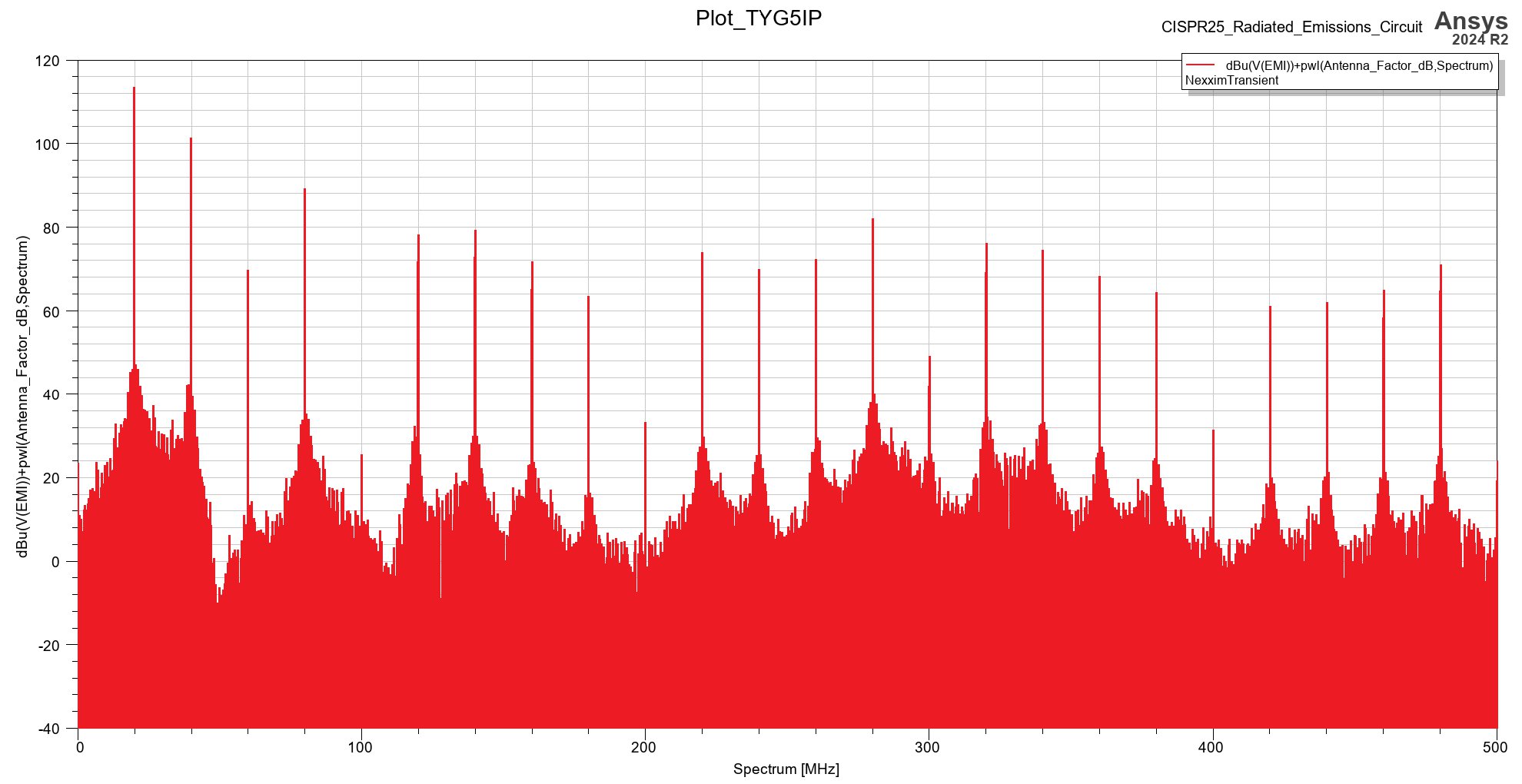
You can customize every aspect of the report. The method crate_report_from_configuration() reads the report configuration from a JSON file and generates the custom report.
[7]:
report1_full = circuit.post.create_report_from_configuration(
os.path.join(project_path, "Spectrum_CISPR_Custom.json")
)
out = circuit.post.export_report_to_jpg(
circuit.working_directory, report1_full.plot_name
)
Image(os.path.join(circuit.working_directory, report1_full.plot_name + ".jpg"))
PyAEDT INFO: Report Plot_GAUX36 created successfully.
[7]:
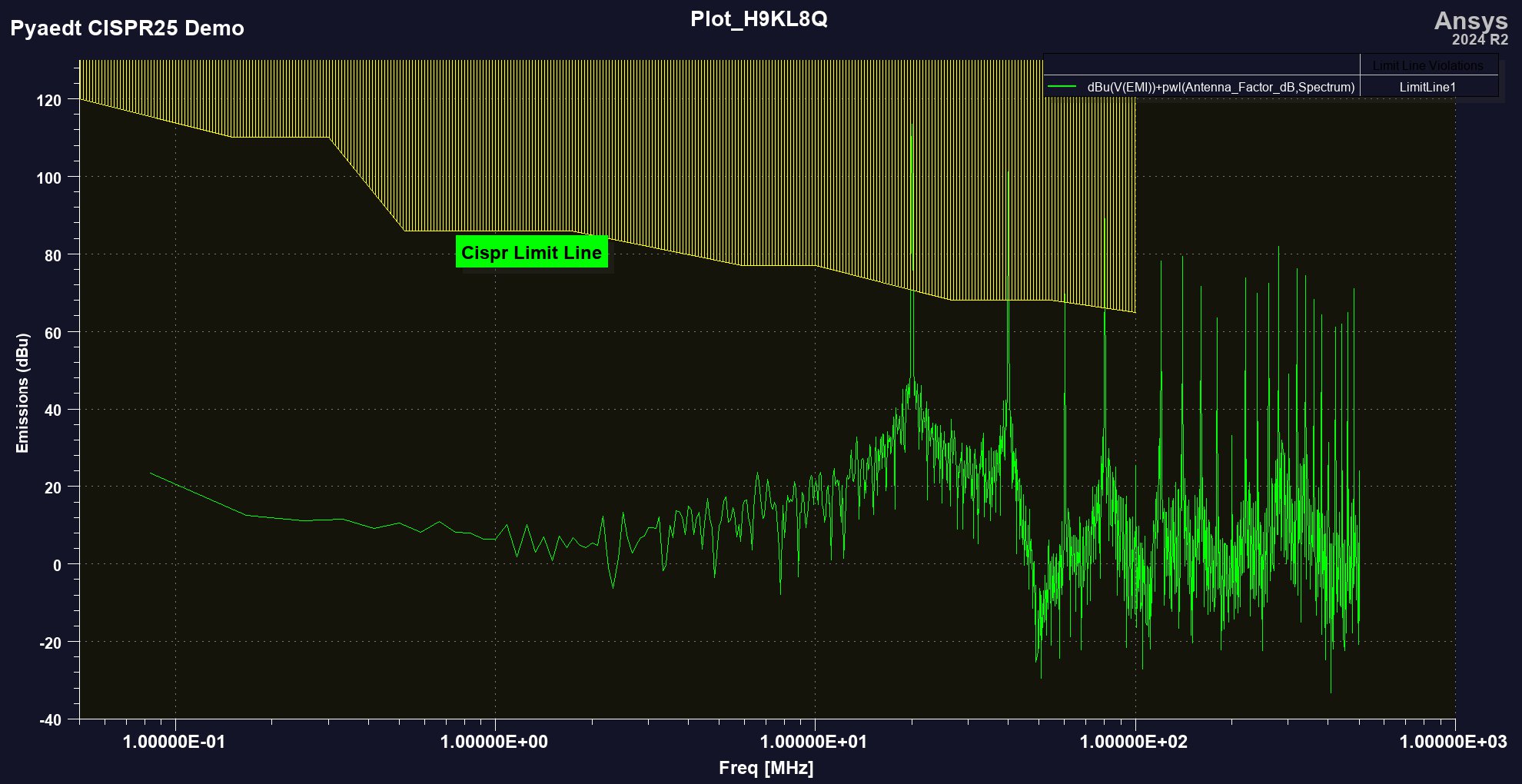
Create a transient report#
The JSON configuration file can be read and modified from the API prior to creating the report. The following code modifies the trace rendering prior to creating the report.
[8]:
props = ansys.aedt.core.generic.file_utils.read_json(
os.path.join(project_path, "Transient_CISPR_Custom.json")
)
report2 = circuit.post.create_report_from_configuration(
report_settings=props, solution_name="NexximTransient"
)
out = circuit.post.export_report_to_jpg(circuit.working_directory, report2.plot_name)
Image(os.path.join(circuit.working_directory, report2.plot_name + ".jpg"))
PyAEDT INFO: Parsing C:\Users\ansys\AppData\Local\Temp\tmpf75nvxk0.ansys\custom_reports\CISPR25_Radiated_Emissions_Example23R1.aedt.
PyAEDT INFO: File C:\Users\ansys\AppData\Local\Temp\tmpf75nvxk0.ansys\custom_reports\CISPR25_Radiated_Emissions_Example23R1.aedt correctly loaded. Elapsed time: 0m 1sec
PyAEDT INFO: aedt file load time 0.6534538269042969
PyAEDT INFO: Report Plot_7D0870 created successfully.
[8]:

The props dictionary can be used to customize any aspect of an existing report or generate a new report. In this example, the name of the curve is customized.
[9]:
props["expressions"] = {"V(Battery)": {}, "V(U1_VDD)": {}}
props["plot_name"] = "Battery Voltage"
report3 = circuit.post.create_report_from_configuration(
report_settings=props, solution_name="NexximTransient"
)
out = circuit.post.export_report_to_jpg(circuit.working_directory, report3.plot_name)
Image(os.path.join(circuit.working_directory, report3.plot_name + ".jpg"))
PyAEDT INFO: Report Plot_XOB33D created successfully.
[9]:
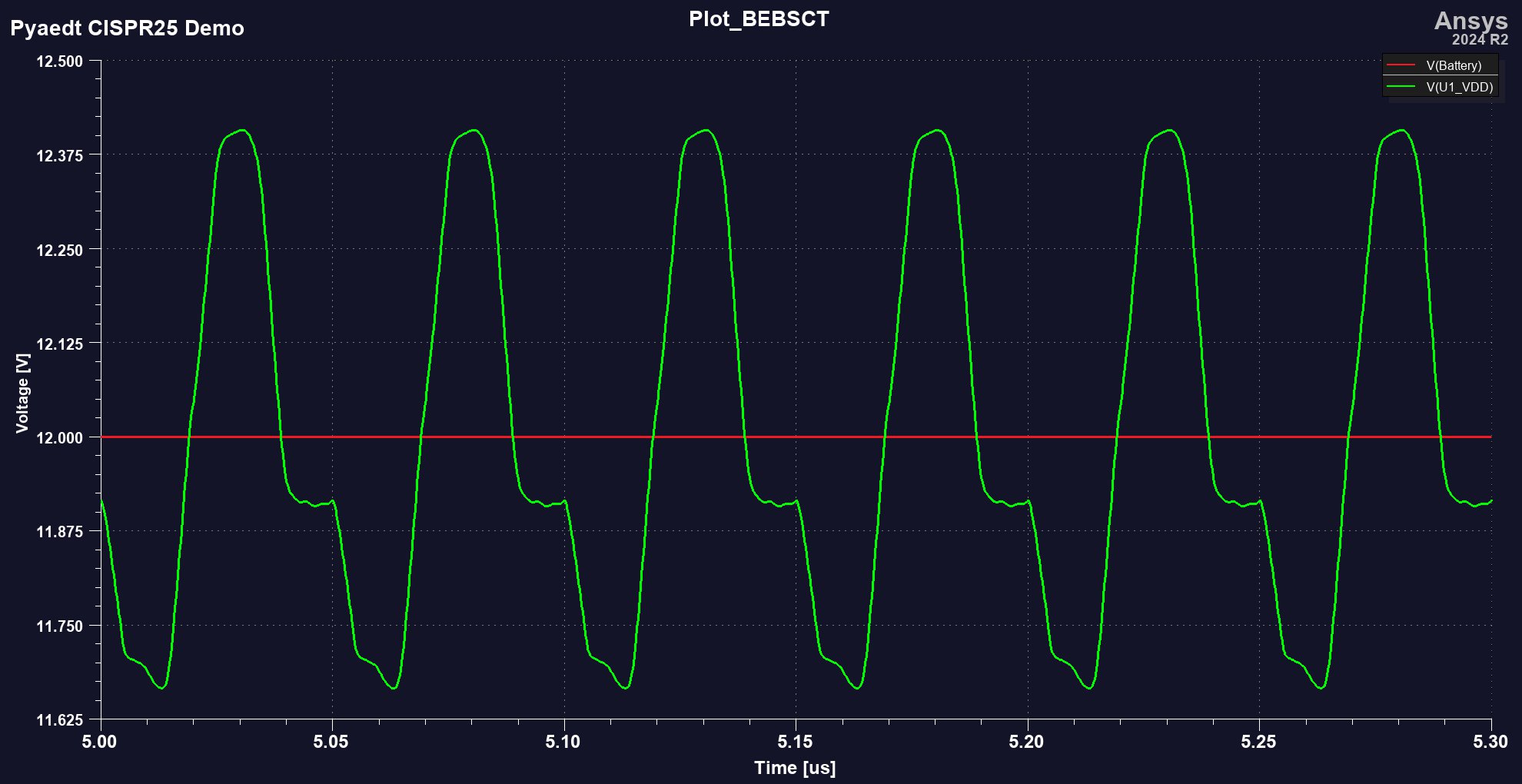
Create an eye diagram#
You can use the JSON file to create an eye diagram. The following code includes the eye.
[10]:
report4 = circuit.post.create_report_from_configuration(
os.path.join(project_path, "EyeDiagram_CISPR_Basic.json")
)
out = circuit.post.export_report_to_jpg(circuit.working_directory, report4.plot_name)
Image(os.path.join(circuit.working_directory, report4.plot_name + ".jpg"))
PyAEDT INFO: Report Plot_5KGKQ1 created successfully.
[10]:
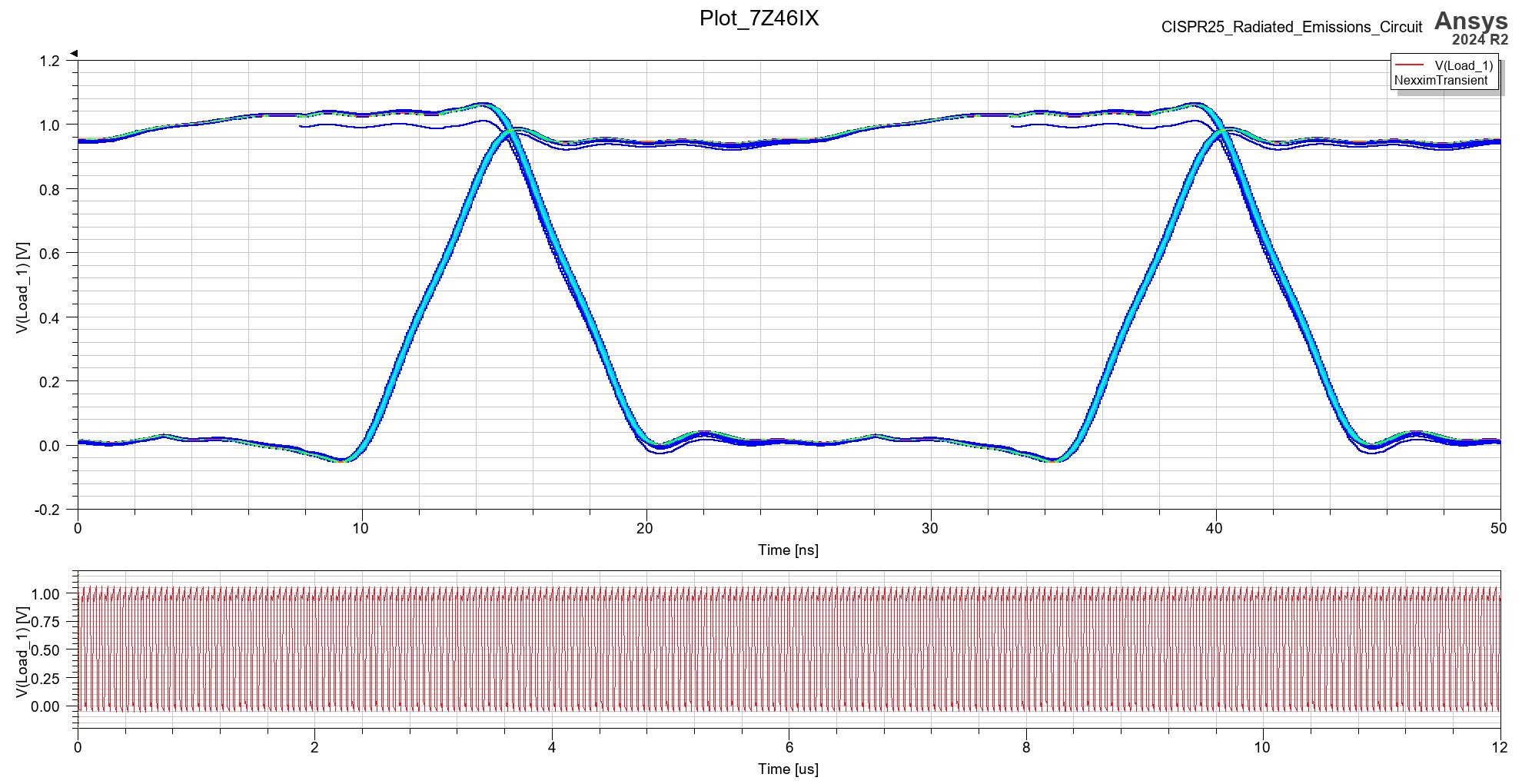
[11]:
report4_full = circuit.post.create_report_from_configuration(
os.path.join(project_path, "EyeDiagram_CISPR_Custom.json")
)
out = circuit.post.export_report_to_jpg(
circuit.working_directory, report4_full.plot_name
)
Image(os.path.join(circuit.working_directory, report4_full.plot_name + ".jpg"))
PyAEDT INFO: Report Plot_P2SQFX created successfully.
[11]:
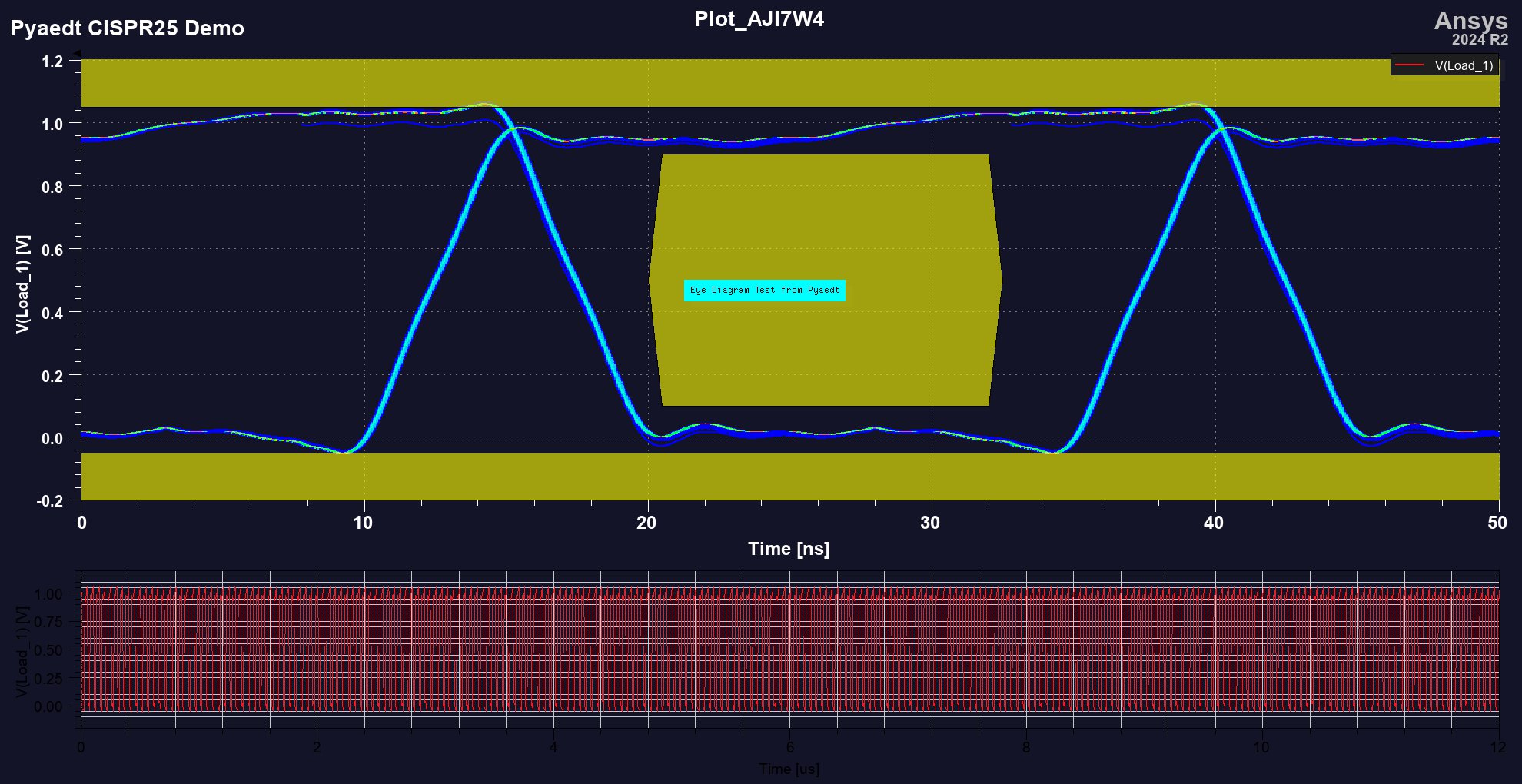
Save project and close AEDT#
Save the project and close AEDT. The example has finished running. You can retrieve project files from temp_folder.name.
[12]:
circuit.save_project()
print("Project Saved in {}".format(circuit.project_path))
PyAEDT INFO: Project CISPR25_Radiated_Emissions_Example23R1 Saved correctly
Project Saved in C:/Users/ansys/AppData/Local/Temp/tmpf75nvxk0.ansys/custom_reports/
[13]:
circuit.release_desktop()
time.sleep(3)
PyAEDT INFO: Desktop has been released and closed.
Clean up#
The following cell cleans up the temporary directory and removes all project files.
[14]:
temp_folder.cleanup()
Download this example
Download this example as a Jupyter Notebook or as a Python script.
